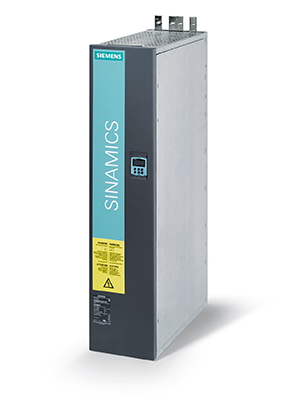DCP DC/DC converter power spectrum extended to 120 kilowatts

- Minimal space requirement due to high switching frequency
- Voltage range up to 920 volts
- UL certification opens up application for American market
Siemens has extended the power range of its Sinamics DCP DC/DC power converter from 30 to 120 kilowatts. The high switching frequency allows the use of smaller chokes, making the Sinamics DCP extremely economical on space.
It covers a voltage range of up to 920 volts DC, and by offering facility for 4x parallel switching it makes available a total output of up to 480 kilowatts. With its UL certification, it also meets the conditions for use in the American market, and compliance with the Drives and Photovoltaic Standard opens up further interesting application scope in these fields for the Sinamics DCP.
The Sinamics DCP DC/DC power converter enables the realization of energy storage systems using for instance batteries or supercaps, offering a range of benefits for the user: As a combined buck/boost converter, the Sinamics DCP can be adapted to the relevant voltage at the input/output, ensuring optimum charging of either a battery or supercap, as well as making available the stored energy to a DC link.
As the control and operating units are also integrated in the device, the DCP is capable of fully independent operation. An overload capacity of up to 150 percent of rated current allows the Sinamics DCP to also be used in the implementation of highly dynamic applications. A Profinet interface is also available for integration into industrial networks.
The Sinamics DCP can be used in applications such as energy storage systems in photovoltaic installations or wind power farms, alongside press applications, diesel-powered harbor cranes, rack handling systems or quick-charging stations for eCars. The Sinamics DCP has already been successfully installed at the Karlsruhe Institute of Technology (KIT) in a hybrid system comprising a battery with 50 kWh and a PV field.
The energy generated is stored partially in the battery or fed into the grid at peak load periods. In another installation near Augsburg, energy generated by a photovoltaic system is stored via Sinamics DCP in a battery. This is used in the event of a power failure, providing the guarantee of practically uninterrupted continued operation of the plant.
For further information on the subject of Sinamics, please see www.siemens.de/sinamics-dcp
Siemens AG (Berlin and Munich) is a global technology powerhouse that has stood for engineering excellence, innovation, quality, reliability and internationality for more than 165 years. The company is active in more than 200 countries, focusing on the areas of electrification, automation and digitalization. One of the world's largest producers of energy-efficient, resource-saving technologies, Siemens is No. 1 in offshore wind turbine construction, a leading supplier of combined cycle turbines for power generation, a major provider of power transmission solutions and a pioneer in infrastructure solutions as well as automation, drive and software solutions for industry. The company is also a leading provider of medical imaging equipment – such as computed tomography and magnetic resonance imaging systems – and a leader in laboratory diagnostics as well as clinical IT. In fiscal 2014, which ended on September 30, 2014, Siemens generated revenue from continuing operations of €71.9 billion and net income of €5.5 billion. At the end of September 2014, the company had around 343,000 employees worldwide on a continuing basis.
Further information is available on the Internet at www.siemens.com
Reference Number: PR2015100016PDEN
Contact
Mr. Stefan Rauscher
Process Industries and Drives Division
Siemens AG
Gleiwitzer Str. 555
90475 Nuremberg
Germany
Tel: +49 (911) 895-7952
Media Contact
All latest news from the category: Trade Fair News
Newest articles

NASA: Mystery of life’s handedness deepens
The mystery of why life uses molecules with specific orientations has deepened with a NASA-funded discovery that RNA — a key molecule thought to have potentially held the instructions for…

What are the effects of historic lithium mining on water quality?
Study reveals low levels of common contaminants but high levels of other elements in waters associated with an abandoned lithium mine. Lithium ore and mining waste from a historic lithium…

Quantum-inspired design boosts efficiency of heat-to-electricity conversion
Rice engineers take unconventional route to improving thermophotovoltaic systems. Researchers at Rice University have found a new way to improve a key element of thermophotovoltaic (TPV) systems, which convert heat…



